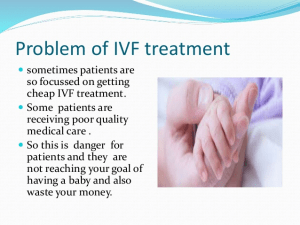What is infertility?
Infertility is a problem of the reproductive system. It affects the body’s ability to reproduce. It could be caused by a problem with the man’s system, the woman’s system, or both. For a pregnancy, the following must happen:
- The man must make healthy sperm.
- The woman must make healthy eggs.
- The fallopian tubes must be open to let the sperm to reach the egg.
- The sperm must be able to fertilize the egg.
- The fertilized egg must implant in the uterus.
- The embryo must be healthy.
Infertility is not just a woman’s concern. Half the time, a male problem causes or contributes. Many couples have more than one factor that plays a role.
In a few cases, a cause for infertility can’t be found. If you think you are not able to get pregnant, see your doctor early. The age of the woman and how long the couple has been trying to get pregnant may affect treatment.
Why is IVF used?
IVF can be used to treat infertility with the following patients:
- Blocked or damaged fallopian tubes
- Male factor infertility including decreased sperm count or sperm motility
- Women with ovulation disorders, premature ovarian failure, uterine fibroids
- Women who have had their fallopian tubes removed
- Individuals with a genetic disorder
- Unexplained infertility
What is involved with In Vitro Fertilization?
There are five basic steps in the IVF and embryo transfer process:
- Monitor and stimulate the development of healthy egg(s) in the ovaries.
- Collect the eggs.
- Secure the sperm.
- Combine the eggs and sperm together in the laboratory and provide the appropriate environment for fertilization and early embryo growth.
- Transfer embryos into the uterus.
Step 1: Fertility medications are prescribed to stimulate egg production. Multiple eggs are desired because some eggs will not develop or fertilize after retrieval. Transvaginal ultrasound is used to examine the ovaries, and blood test samples are taken to check hormone levels.
Step 2: Eggs are retrieved through a minor surgical procedure that uses ultrasound imaging to guide a hollow needle through the pelvic cavity to remove the eggs. Medication is provided to reduce and remove potential discomfort.
Step 3: The male is asked to produce a sample of sperm, which is prepared for combining with the eggs.
Step 4: In a process called insemination, the sperm and eggs are mixed together and stored in a laboratory to encourage fertilization. In some cases where there is a lower probability of fertilization, intracytoplasmic sperm injection (ICSI) may be used. Through this procedure, a single sperm is injected directly into the egg in an attempt to achieve fertilization. The eggs are monitored to confirm that fertilization and cell division are taking place. Once this occurs, the fertilized eggs are considered embryos.
Step 5: The embryos are usually transferred into the woman’s uterus three to five days following egg retrieval and fertilization. A catheter or small tube is inserted into the uterus to transfer the embryos. This procedure is painless for most women, although some may experience mild cramping. If the procedure is successful, implantation typically occurs around six to ten days following egg retrieval.
How successful is in vitro fertilization?
The success rate of IVF clinics depends on a number of factors including reproductive history, maternal age, cause of infertility, and lifestyle factors. It is also important to understand that pregnancy rates are not the same as live birth rates.
The live birth rate for each IVF cycle started is approximately:
- 41-43% for women under age 35
- 33-36% for women ages 35 to 37
- 23-27% for women ages 38 to 40
- 13-18% for women ages over 40
What if I don’t produce healthy eggs or my husband is sterile?
You may choose to use donor eggs, sperm, or embryos. However, make sure to talk with a counselor experienced with donor issues. You will want to be informed about various legal issues related to gamete donation including the legal rights of the donor.
How many embryos should be created or transferred?
The number of embryos transferred typically depends on the number of eggs collected and maternal age. As the rate of implantation decreases as women age, more eggs may be implanted depending on age to increase the likelihood of implantation. However, a greater number of eggs transferred increases the chances of having a multiples pregnancy. Make sure to talk with your doctor before the procedure so you both agree on how many embryos to implant.
How much does it cost for IVF treatment?
There are many factors like age, current health and body condition of both partners and hormonal levels of female. An average it costs around $1,000 in India but same IVF treatment costs $12,400 in U.S.
How do I choose an infertility clinic?
There are a number of questions to ask regarding the cost and details of specific centers and fertility programs. Expert Chikitsa can help you to resolve all your queries and assists in making more rational and informed decisions.

